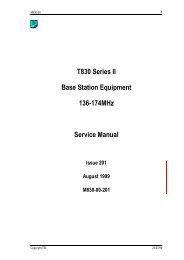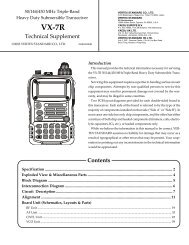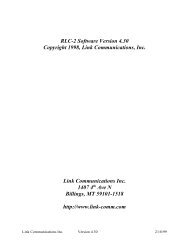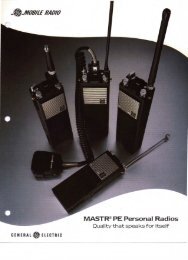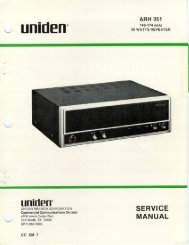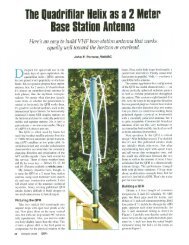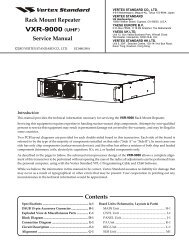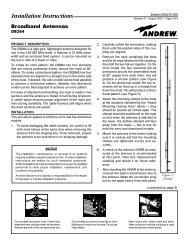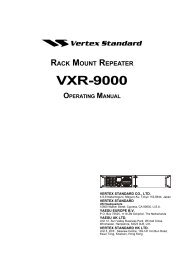TK-880/H (UHF) mobile service manual - The Repeater Builder's ...
TK-880/H (UHF) mobile service manual - The Repeater Builder's ...
TK-880/H (UHF) mobile service manual - The Repeater Builder's ...
You also want an ePaper? Increase the reach of your titles
YUMPU automatically turns print PDFs into web optimized ePapers that Google loves.
CIRCUIT DESCRIPTION<br />
<strong>TK</strong>-<strong>880</strong>/H<br />
■ Display Circuit<br />
<strong>The</strong> CPU (IC511) controls the shift register (IC508) and<br />
display LEDs. When the LG line goes high when the transceiver<br />
is busy, Q508 turns on and the green LED on D511<br />
lights. In transmit mode, the LR line goes high, Q509 turns<br />
on and the red light lights. Backlighting LEDs for the key<br />
operation unit (D512~D517) and LCD are provided.<br />
When the KBLC line goes high, Q512 turns on, then<br />
Q513 turns on, and the key illumination LED lights. A voltage<br />
is applied to the LEDA line to turn on the LCD backlight.<br />
IC508<br />
Shift<br />
register<br />
KBLC<br />
LG<br />
Q512<br />
SW<br />
Q508<br />
SW<br />
Q513<br />
SW<br />
D511<br />
LEDA<br />
D512~517<br />
GRN<br />
MO is summed with the external pin DI line by the summing<br />
amplifier (IC3) and the resulting signal goes to the D/A<br />
converter (IC5). <strong>The</strong> D/A converter (IC5) adjusts the MO<br />
level and the balance between the MO and TO levels. Part<br />
of a TO signal is summed with an output signal from pin 3<br />
(MO) of IC5 and the resulting signal goes to the MD pin of<br />
the VCO. This signal is applied to a varicap diode in the VCO<br />
for direct FM modulation.<br />
IC511<br />
CPU<br />
LSDO<br />
AFDAT<br />
HSDO<br />
MIC<br />
IC504<br />
Audio<br />
processor<br />
IC506<br />
Analog<br />
SW<br />
TX-RX UNIT (A/2)<br />
TO<br />
MO<br />
DI<br />
IC3<br />
SUM<br />
AMP<br />
MB<br />
X1<br />
VCXO<br />
IC5<br />
D/A<br />
MD<br />
IC300<br />
PLL<br />
A1<br />
VCO<br />
HT<br />
LR<br />
Q509<br />
SW<br />
RED<br />
Fig. 13<br />
Encode<br />
Fig. 11<br />
Display circuit<br />
■ Key Matrix Circuit<br />
<strong>The</strong> <strong>TK</strong>-<strong>880</strong>/<strong>880</strong>H front panel has ten keys. Each of them<br />
is connected to a cross point of a matrix of the KEY1 to KEY7<br />
ports of the microprocessor. <strong>The</strong> KEY5 to KEY7 ports are<br />
always high, while the KEY1 to KEY4 ports are always low.<br />
<strong>The</strong> microprocessor monitors the status of the KEY1 to<br />
KEY7 ports. If the state of one of the ports changes, the<br />
microprocessor assumes that the key at the matrix point<br />
corresponding to that port has been pressed. Unused<br />
points (KEY1 to KEY7) are also used for foot switch (FSW)<br />
input.<br />
IC511<br />
CPU<br />
KEY7<br />
KEY6<br />
KEY5<br />
KEY4<br />
KEY3<br />
KEY2<br />
KEY1<br />
Fig. 12<br />
VOL<br />
UP<br />
MONI<br />
VOL<br />
DOWN<br />
A<br />
B<br />
D SCAN SYS<br />
DOWN<br />
C<br />
Q511<br />
SYS<br />
UP<br />
Key matrix circuit<br />
FSW<br />
■ Encode<br />
<strong>The</strong> QT, DQT, and LTR signals are output from LSDO of<br />
the CPU (IC511) and go to the D/A converter (IC5) of the TX-<br />
RX unit (A/2). <strong>The</strong> DTMF signal is output from HSDO of the<br />
CPU and goes to the audio processor (IC504). An MSK signal<br />
is output from the audio processor according to the data<br />
(AFDAT) from the CPU. <strong>The</strong> signal is summed with a MIC/<br />
MSK signal by the audio processor (IC504), and the resulting<br />
signal passes through an analog switch (IC506) and goes to<br />
the TX-RX unit (A/2) (MO).<br />
■ Decode<br />
<strong>The</strong> signal (DEO) detected by the TX-RX unit (A/2) passes<br />
through two low-pass filters of IC501, goes to LSDI of the<br />
CPU (IC511) to decode QT, DQT, and LTR. <strong>The</strong> DTMF signal<br />
is decoded by a dedicated IC (IC507) and the resulting signal<br />
is sent to the CPU (IC511) as serial data (STD).<br />
IC511<br />
CPU<br />
IC501(2/2)<br />
LPF<br />
LSDI<br />
STD<br />
IC507<br />
DTMF<br />
DECO.<br />
Fig. 14<br />
IC501(1/2)<br />
LPF<br />
Decode<br />
DEO<br />
■ D/A Converter<br />
<strong>The</strong> D/A converter (IC5) is used to adjust TONE and MO<br />
modulation, beep, AF volume, TV voltage, FC reference voltage,<br />
and PC POWER CONTROL voltage level.<br />
Adjustment values are sent from the CPU as serial data.<br />
<strong>The</strong> D/A converter has a resolution of 256 and the following<br />
relationship is valid:<br />
D/A output = (Vin – VDAref) / 256 x n + VDAref<br />
Vin: Analog input<br />
VDAref: D/A reference voltage<br />
n: Serial data value from the microprocessor (CPU)<br />
31



